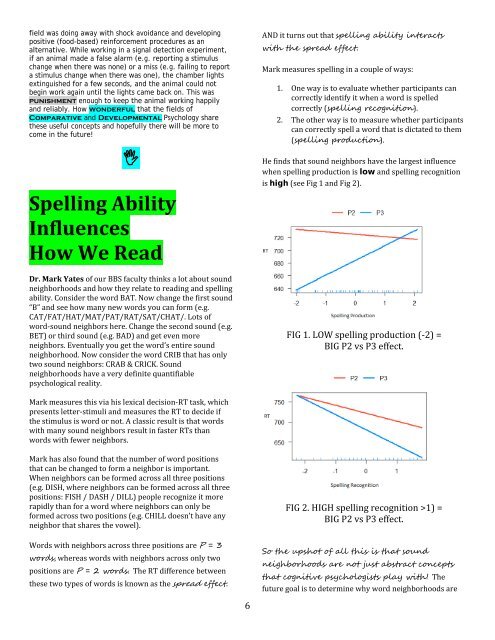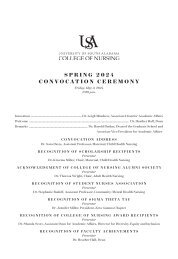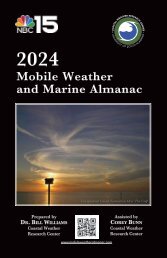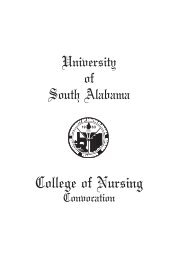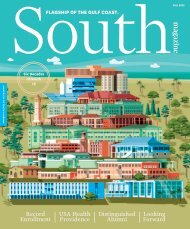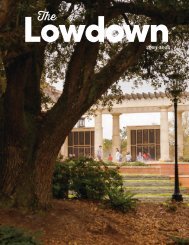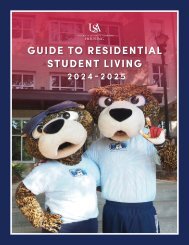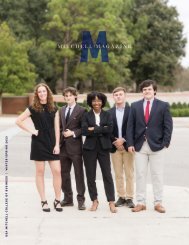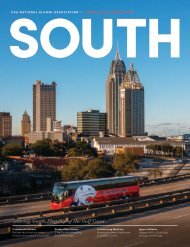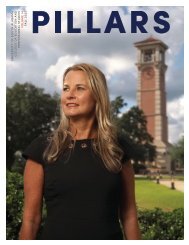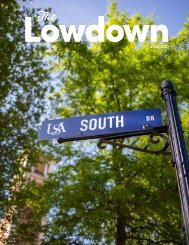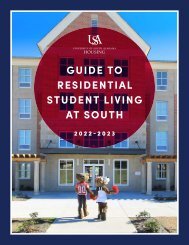Psychology Department Newsletter USA Winter 2016
You also want an ePaper? Increase the reach of your titles
YUMPU automatically turns print PDFs into web optimized ePapers that Google loves.
field was doing away with shock avoidance and developing<br />
positive (food-based) reinforcement procedures as an<br />
alternative. While working in a signal detection experiment,<br />
if an animal made a false alarm (e.g. reporting a stimulus<br />
change when there was none) or a miss (e.g. failing to report<br />
a stimulus change when there was one), the chamber lights<br />
extinguished for a few seconds, and the animal could not<br />
begin work again until the lights came back on. This was<br />
punishment enough to keep the animal working happily<br />
and reliably. How wonderful that the fields of<br />
Comparative and Developmental <strong>Psychology</strong> share<br />
these useful concepts and hopefully there will be more to<br />
come in the future!<br />
<br />
Spelling Ability<br />
Influences<br />
How We Read<br />
Dr. Mark Yates of our BBS faculty thinks a lot about sound<br />
neighborhoods and how they relate to reading and spelling<br />
ability. Consider the word BAT. Now change the first sound<br />
“B” and see how many new words you can form (e.g.<br />
CAT/FAT/HAT/MAT/PAT/RAT/SAT/CHAT/. Lots of<br />
word-sound neighbors here. Change the second sound (e.g.<br />
BET) or third sound (e.g. BAD) and get even more<br />
neighbors. Eventually you get the word’s entire sound<br />
neighborhood. Now consider the word CRIB that has only<br />
two sound neighbors: CRAB & CRICK. Sound<br />
neighborhoods have a very definite quantifiable<br />
psychological reality.<br />
AND it turns out that spelling ability interacts<br />
with the spread effect.<br />
Mark measures spelling in a couple of ways:<br />
1. One way is to evaluate whether participants can<br />
correctly identify it when a word is spelled<br />
correctly (spelling recognition).<br />
2. The other way is to measure whether participants<br />
can correctly spell a word that is dictated to them<br />
(spelling production).<br />
He finds that sound neighbors have the largest influence<br />
when spelling production is low and spelling recognition<br />
is high (see Fig 1 and Fig 2).<br />
FIG 1. LOW spelling production (-2) =<br />
BIG P2 vs P3 effect.<br />
Mark measures this via his lexical decision-RT task, which<br />
presents letter-stimuli and measures the RT to decide if<br />
the stimulus is word or not. A classic result is that words<br />
with many sound neighbors result in faster RTs than<br />
words with fewer neighbors.<br />
Mark has also found that the number of word positions<br />
that can be changed to form a neighbor is important.<br />
When neighbors can be formed across all three positions<br />
(e.g. DISH, where neighbors can be formed across all three<br />
positions: FISH / DASH / DILL) people recognize it more<br />
rapidly than for a word where neighbors can only be<br />
formed across two positions (e.g. CHILL doesn’t have any<br />
neighbor that shares the vowel).<br />
Words with neighbors across three positions are P = 3<br />
words, whereas words with neighbors across only two<br />
positions are P = 2 words. The RT difference between<br />
these two types of words is known as the spread effect.<br />
FIG 2. HIGH spelling recognition >1) =<br />
BIG P2 vs P3 effect.<br />
So the upshot of all this is that sound<br />
neighborhoods are not just abstract concepts<br />
that cognitive psychologists play with! The<br />
future goal is to determine why word neighborhoods are<br />
6


